With the following code I create two version of the date value (one is string, progressDateString, another is Date type, progressDate):
var parseTime = d3.timeParse("%d-%b-%y");
var formatTime = d3.timeFormat("%d-%b-%y");
data = d3.csvParse(data, function (d) {
return {
progress: d.Progress,
progressDate: parseTime(d.ProgressDate),
//Fri Jul 12 2019 00:00:00 GMT+0200
progressDateString: formatTime(parseTime(d.ProgressDate)),
//12-Jul-19
};
});
I want to display the dates in 12-Jul-19 format in the x axis with the code below, however it does not print the date values
const xScale = d3.scaleLinear()
.range([0, width])
.domain([d3.min(data, d => { return d.progressDateString }), d3.max(data, d => { return d.progressDateString })]);
However, instead, if I use progressDate, I get the following chart, where everything is overlapping in the x axis:
Any ideas, why I cannot get it work with progressDateString value? In this post, it seems that it should work. I appreciate any help.
Just in case it may help, I am sharing the whole code below:
var parseTime = d3.timeParse("%d-%b-%y");
var formatTime = d3.timeFormat("%d-%b-%y");
data = d3.csvParse(data, function (d) {
return {
progress: d.Progress,
progressDate: parseTime(d.ProgressDate),
progressDateString: formatTime(parseTime(d.ProgressDate)),
};
});
console.log(data[2].progressDate);
const height = 300,
width = 400,
margins = { top: 20, right: 100, bottom: 50, left: 50 };
const chart = d3.select('.chart')
.attr('width', width + margins.left + margins.right)
.attr('height', height + margins.top + margins.bottom)
.append('g')
.attr('transform', 'translate(' + margins.left + ',' + margins.top + ')');
const xScale = d3.scaleLinear()
.range([0, width])
.domain([d3.min(data, d => { return d.progressDate }), d3.max(data, d => { return d.progressDate })]);
const yScale = d3.scaleLinear()
.range([0, height])
.domain([d3.max(data, d => { return d.progress }), 0]);
const dots = chart.selectAll('dot')
.data(data)
.enter().append('circle')
.attr('r', 5)
.attr('cx', d => { return xScale(d.progressDate); })
.attr('cy', d => { return yScale(d.progress) })
.style('fill', 'indianred');
chart.selectAll('text')
.data(data)
.enter().append('text')
.text(d => { return d.Name; })
.attr('x', d => { return xScale(d.progressDate); })
.attr('y', d => { return yScale(d.progress); })
.attr('transform', 'translate(10,5)');
chart.append('g')
.attr('transform', 'translate(0,' + height + ')')
.call(d3.axisBottom(xScale));
chart.append('g')
.call(d3.axisLeft(yScale));
chart.append('text')
.style('font-size', '14px')
.style('text-anchor', 'middle')
.attr('x', width / 2)
.attr('y', height + 50)
.text('Seconds Behind Fastest Time')
chart.append('text')
.style('font-size', '14px')
.style('text-anchor', 'middle')
.attr('x', height / -2)
.attr('y', -30)
.attr('transform', 'rotate(-90)')
.text('Ranking')
